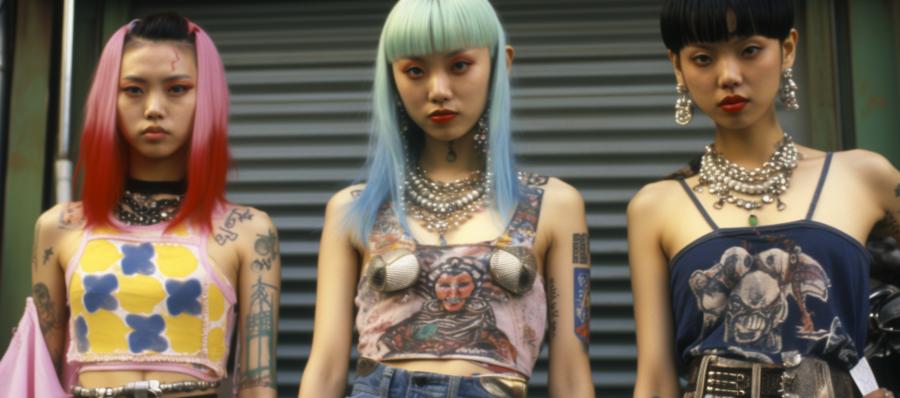Harajuku Phenomenon: Tokyo Street Fashion's Early 2000s Wave

A Colorful Explosion of Creativity and Self-Expression
Not since the fall of the Berlin Wall has there been such a celebration of human freedom, as what occurred on the streets of Tokyo in the early 2000s. This was a time when the creative spirits of Japanese youth found their ultimate realization in the Harajuku phenomenon. This colorful explosion of creativity and self-expression became synonymous with Tokyo street fashion, where clothing served as a canvas for young people to showcase their individuality and artistic flair. With a myriad of colors, textures, and styles, the Harajuku wave was a fascinating spectacle that captured the world's attention.From Simple Beginnings to Global Sensation
In the late 1990s, the streets of Harajuku began to see a change. Young people started to don vibrant, eclectic ensembles that challenged the conventional norms of fashion. This was the birth of a new movement, one that would grow and evolve over the next decade, culminating in the Harajuku phenomenon.The early 2000s marked the height of this cultural wave, with the Harajuku district becoming a mecca for Tokyo's most fashionable and avant-garde youth. With each passing weekend, the bustling streets were transformed into an open-air runway, as countless young people strutted their stuff in their finest and most imaginative outfits. These fashion-forward pioneers, known as Harajuku girls (and boys), came to embody the spirit of the movement, and their unique styles ultimately captured the imagination of the fashion world.
The Birth of Subcultures and the Harajuku Mosaic
As the Harajuku phenomenon grew, so too did the diversity of styles on display. The streets of Tokyo became a melting pot of fashion subcultures, each with its own distinct aesthetic and identity. Among these, a few key trends emerged as cornerstones of the Harajuku wave.- Gothic Lolita: Combining Victorian-era frills and lace with a dark gothic twist, this style was characterized by its elaborate dresses, petticoats, and bonnets. Think "Alice in Wonderland" meets "Dracula" for a high tea party.
- Visual Kei: Inspired by the flamboyant costumes and makeup of Japanese glam rock bands, Visual Kei devotees embraced a theatrical, androgynous look complete with gravity-defying hair and dramatic eye makeup.
- Decora: The epitome of "more is more," Decora fashionistas piled on colorful layers of clothing and accessories, creating a kaleidoscope of beads, bows, and plush toys. It was a visual feast that could leave you with a sugar high.
- Kogal: Channeling a rebellious schoolgirl aesthetic, Kogal fashion featured loose socks, mini-skirts, and school blazers worn with an air of defiance that would make James Dean proud.
A Global Influence & the Decline of Harajuku
As the Harajuku phenomenon reached its zenith, its influence began to spread far beyond the streets of Tokyo. Designers from around the world started to take note, drawing inspiration from the fearless creativity of these young fashion rebels. This led to a surge in popularity for Japanese street fashion, with the likes of Gwen Stefani and her entourage of "Harajuku Girls" bringing the style to mainstream audiences.However, as with any cultural wave, the Harajuku phenomenon could not sustain its peak forever. By the mid-2000s, the scene began to lose some of its vibrancy, as mainstream fashion trends increasingly co-opted the once-unique Harajuku aesthetic. The streets that were once filled with daring and inventive self-expression started to become more homogenized, and the Harajuku wave began to recede.
The Legacy of the Harajuku Phenomenon
Although the height of the Harajuku phenomenon may have passed, its impact on the fashion world cannot be denied. The spirit of the movement lives on in the countless designers, artists, and creatives who were inspired by its bold and fearless approach to self-expression. From high fashion runways to the DIY ethos of today's young designers, the influence of the Harajuku wave can still be felt around the globe.Final Thoughts: A Celebration of Creativity and Individuality
The Harajuku phenomenon was much more than a fleeting fashion trend - it was a celebration of creativity, individuality, and the limitless potential of the human spirit. In a world that often seeks to suppress our uniqueness, the Harajuku wave serves as a powerful reminder that we should never be afraid to stand out, to take risks, and to embrace the full spectrum of our artistic selves.So, as you don your next ensemble, be it a suit, a dress, or a fantastical concoction of colors and textures, remember the fearless spirit of the Harajuku wave and never hesitate to express your true self through the art of fashion.
Article kindly provided by foreverinfashion.org
Latest Articles
- Style That Works With Your Body, Not Against It
- Fashion Tourism on Wheels: Curated Shopping Routes Led by Chauffeur Guides
- The Charm of Certainty in a World of Indecision
- Can an Everyday T-Shirt Be Turned into a Modern Heirloom?
- Color, Ceremony, and the Psychology of Celebration
- Styling Graphic T-Shirts for Different Body Types
- Getting Kids to Wear Their Hats Without a Bribe or a Meltdown
- Mastering the Art of Being the Unnoticed Photographer
- Quiet Sportswear Moves Loudly
- Fashion's Most Misunderstood Color Is Brown
- Weight Matters When Cotton Gets Real
- SKU's Out for Summer: Why Your Warehouse Is Melting Down
- Ink as Accessory - How Tattoos Are Replacing Jewelry in Modern Style
- Decoding the Y2K Aesthetic with Style and Sanity
- Accessories
- Jewellery
- Footwear
- Skirts and Dresses
- Shirts and Blouses
- Beauty and Makeup
- Fashion Photography
- Sustainable Fashion
- Street Style
- Fashion History
- Fashion Business
- Fashion Styling
- Fashion Events
- Plus-Size Fashion
- Men's Fashion
- Women's Fashion
- Fashion Blogging
- Fashion Trends
- Fashion Retailers
- Fashion Tips and Advice
- Fashion Business Startups
- Fashion Around the World
- Lingerie
- Sportswear
- Weddings

